Saturday, 29 August 2015: Shrine, fire engines, and drone in Lamego
Written 5 May 2016
On Saturday, the ship cast off from Pinhão well before breakfast time to cruise downstream, back to Régua. Swallows were zooming around the lock we passed through during breakfast.
Promptly at 9:00 a.m., we docked to find the buses waiting to take us on the morning's excursion, south to Lamego. Outward bound, we crossed the river on the new new, high superhighway bridge. Coming back, we crossed the low masonry bridge. The masonry bridge was built for the railroad, but the grade on the far side proved too steep, so architect Edgar Cardozo converted it for auto traffic in 1949.
Things we learned on the way:
- I spotted altitude markers saying that we had reached 140 m as we finished crossing the bridge and 500 m as we exited the freeway to Lamego.
- Kathy recommends novelist Paolo Coelho but doesn't know how good his books are in English. She reads them in Portuguese. She says he writes weird books, very emotional.
- Portugal has both the highest percentage of people with college degrees and highest level of unemployment in Europe: 12-15%, but it drops to 9-11 in summer because of seasonal jobs (wine etc.)
- We should look for Little Britain, a rude britcom.
- The Douro is the only river Viking does in Portugal. They'll add a third ship next year.
In 1139, when Alfonso Enriques was thinking of founding Portugal, he went to Lamego (then the major town in the region; the oldest parts of its cathedral date from 1129) to garner approval and support from the nobles. Although the foundation itself is usually dated from 1143, the pope only recognized Portugal in 1178.
Lamego was fiercely fought over by the Moors and the Christians and finally was established as a Christian stronghold in 1057, by the great grandfather of Alfonso Enriques.
In the 14th century, a the Pilgrimage Chapel of St. Stephen was built, on St. Stephen's hill, in Lamego to shelter pilgrims on the way to Santiago (I saw a little sign with a scallop shell and a directional arrow). In the 16th century, a sculpture of a breast-feeding madonna was brought from Rome, and a larger chapel was built on the same site to accommodate her—the chapel of Our Lady of Remedies. It became the oldes place of pilgrimage in Portugal and was a major destination in the 16th century.
In the 17th century, it was the capital of port wine. Lots of large manor houses surround the center of the city. Anybody who was anybody had to have a house there. Then came the civil war between brothers Miguel I and Peter IV. Lamego sided with absolutist Miguel was the absolutist Miguel, who lost. Peter took it ill and expelled all its religious orders, which crippled the town.
Now thanks to the construction of new roads, Lamego has grown to be a big city again. In June of 2015, just before we were there, Lamego had been chosen to be the center of national festivities, and all the monuments were cleaned. The signs are still up. We were assured that Lamego has more cultural heritage per square meter than anywhere else in Portugal. Its culinary specialties are sparkling wine, smoked ham, and bolo de Lamego, which is a meat-filled bread.
On the outskirts, we spotted a Leclerc big-box store, definitely the result of the French influence.
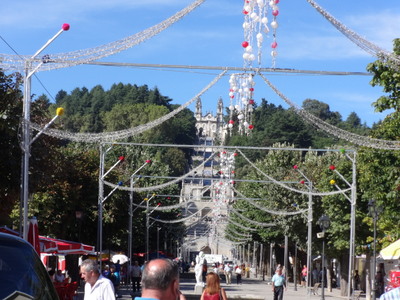
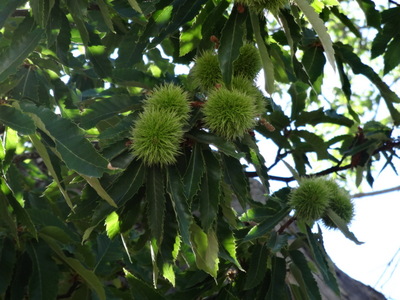 In keeping with the traditions of the time, the chapel had to be really high up and really difficult to walk to. The left-hand photo is a view from the square in front of the town's museum up the long sloping avenue leading toward the hill, and then up the monumental stairway that zigzags up a dozen terraces to the chapel at the top (686 steps). The day we were there was the first day of the chapel's annual festival, so the view was heavily festooned with strings of colored lights. Presumably in normal times it doesn't look quite so much like it's been taken over by the utility companies.
In keeping with the traditions of the time, the chapel had to be really high up and really difficult to walk to. The left-hand photo is a view from the square in front of the town's museum up the long sloping avenue leading toward the hill, and then up the monumental stairway that zigzags up a dozen terraces to the chapel at the top (686 steps). The day we were there was the first day of the chapel's annual festival, so the view was heavily festooned with strings of colored lights. Presumably in normal times it doesn't look quite so much like it's been taken over by the utility companies.
Fortunately, we didn't have to climb the monumental staircase. The Viking buses took up up the back way all the way to the top. There, we had the option of taking the buses back down or of walking all the way down the monumental staircase. Given the state of my knees, we opted for the bus. Particularly enthusiastic pilgrims make the climb on their knees. We saw one lady doing just that.
The photo at the right shows green chestnuts growing on one to two ancient trees beside the chapel. The chapel itself is beautiful. We had a guide tour, but as usual, no photography was allowed. The facade was finished in 1761. It has a gorgeous Wedgewood blue-and-white ceiling decorated with grapes, musical instruments, floral motifs, angels, and of course, the madonna. Nicolao Nazoni made the fountain at the sanctuary. A huge gilded niche in the apse accommodates the statue of our lady, which is only a couple of feet high.
I was astonished to see that the votive candles in the church are electric! Rather than lighting one with a match, you put a coin a slot that lights one or more of them up! I suppose it makes sense, to keep all the smoke from blackening that beautiful ceiling.
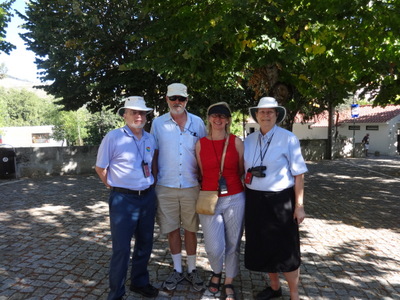
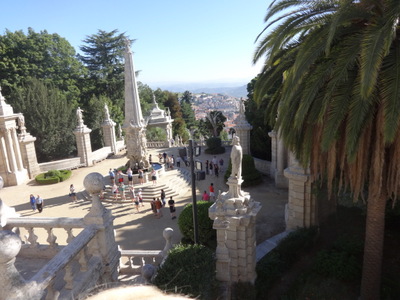 Here we are (David, Buz, Kathy, and me) under one of the chestnut trees.
Here we are (David, Buz, Kathy, and me) under one of the chestnut trees.
At the right is the view down from terrace in front of the chapel to the first terrace. of the staircase. Each is heavily decorated with sculpture, plantings, tiles, and fountains. Unfortunately, I couldn't get a shot that showed the succession of terraces without climbing down at least one or two (and then back up again), and it was too hot for that. This top terrace is decorated with statues of the 16 kings of Israel. You can't see the blue glazed tiles depicting the life of christ from the top, because they are on the downhill faces of the terraces.
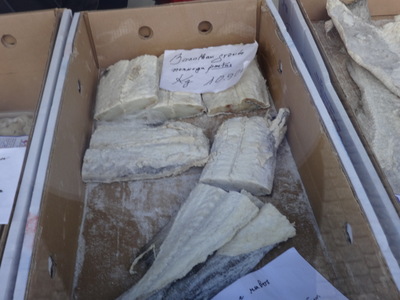
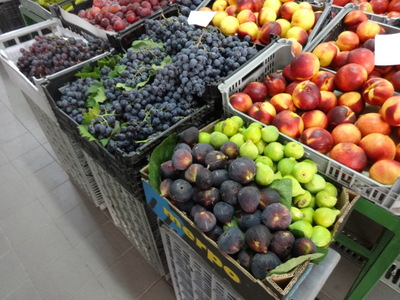 After our tour of the chapel and time spent admiring the views in all directions and the lovely and ancient plantings, we caught the Viking bus back down to the square.
After our tour of the chapel and time spent admiring the views in all directions and the lovely and ancient plantings, we caught the Viking bus back down to the square.
Kathy and I, as is our wont, found and toured the local covered market. At the left here is a box of pieces of dried salt cod at 10.90 euros/kg. Every market we visited featured dried salt cod, which is still a very popular item in Portugal, where fresh cod is relatively rare, apparently not worth bothering with.
At the right is a sampling of the fruit assortment. It includes three colors of grapes, green and purple figs, peaches, and nectarines. Also available were several colors of apples, several of pears, bananas, oranges, lemons, prune plums, greengage plums, watermelons, and the big white melons (Canary melons) we've been eating all week.
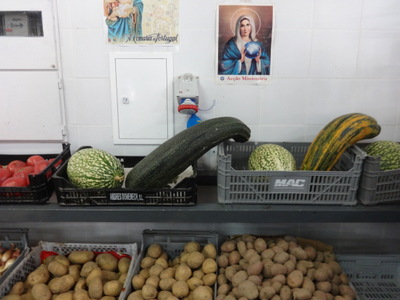
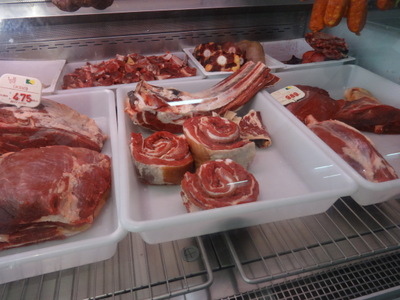 Here are several varieties of potatoes, squashes/gourds, and tomatoes. We also saw other colors of potatoes, onions, red and green bell peppers, and fresh greens.
Here are several varieties of potatoes, squashes/gourds, and tomatoes. We also saw other colors of potatoes, onions, red and green bell peppers, and fresh greens.
The meats included this assortment of beef. Note the heap of back-bone sections (near the top, to the right of center, marked by the white circles of cross-sectioned cartilage), displayed with a couple of potatoes (subtly suggesting they are for stewing), and in the top right corner the ends of a bunch of hanging sausages above a smoked hock of something. Another bin held a heap of pig ears and tails. At a poultry counter we found mostly chickens, whole and cut up.
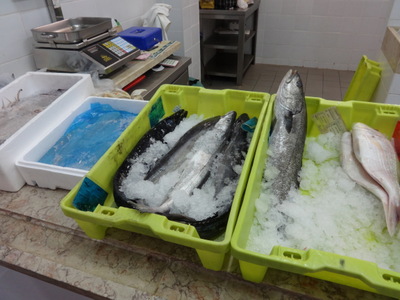
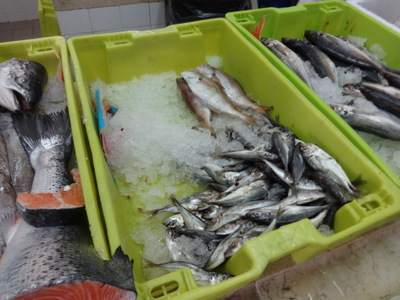 The fish were mostly offered whole, although some of the larger ones, like salmon, could be bought in chunks or slices. I could identify hake, bar (sea bass), something that looked like pale snappers, salmon, a gadid or some sort, sardines, mackerel-like things, and a couple of others about which I have no clue (like the three redish buys in the right-hand photo and the ones in the bin to their right, which might be scombrids, I guess; can anybody give me a hint?).
The fish were mostly offered whole, although some of the larger ones, like salmon, could be bought in chunks or slices. I could identify hake, bar (sea bass), something that looked like pale snappers, salmon, a gadid or some sort, sardines, mackerel-like things, and a couple of others about which I have no clue (like the three redish buys in the right-hand photo and the ones in the bin to their right, which might be scombrids, I guess; can anybody give me a hint?).
No one seemed to be offering ready-cut filets, but maybe they would cut a whole fish up for you once you bought it.
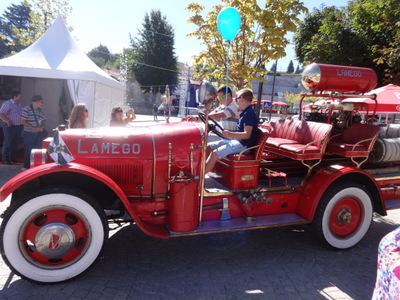
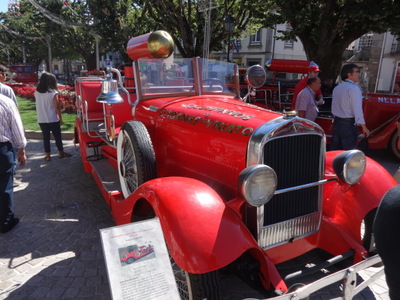 The market was great, but the real highlight was the theme of this year's festival—antique fire engines! Dozens had been gathered from all over the region and lined up along the broad central avenue. Some were roped off, but many were available for touching, close inspection, and even climbing aboard!
The market was great, but the real highlight was the theme of this year's festival—antique fire engines! Dozens had been gathered from all over the region and lined up along the broad central avenue. Some were roped off, but many were available for touching, close inspection, and even climbing aboard!
I think the big torpedo-shaped things mounted on top of many of them are pump cylinders—water for the hoses was still hand pumped relatively recently.
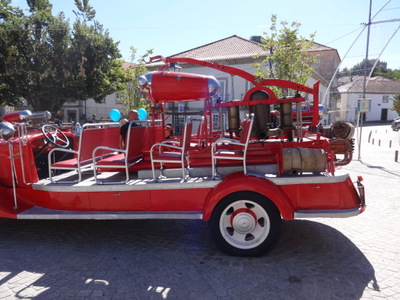
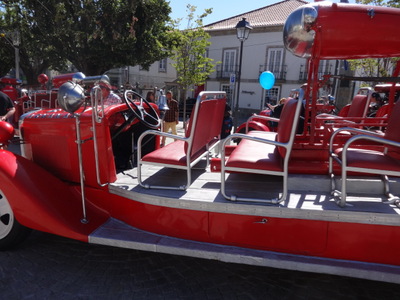 No clinging to the running boards for these firemen; the engine had seats like a bus, to make sure everyone got there.
No clinging to the running boards for these firemen; the engine had seats like a bus, to make sure everyone got there.
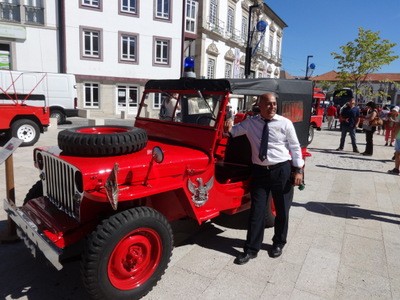
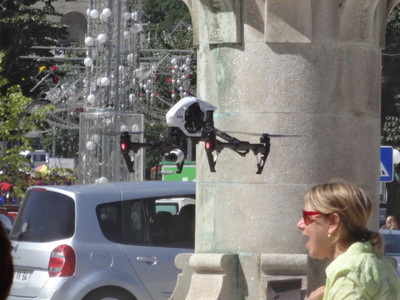 The Viking bus drivers were delighted with the fire engines, examining them minutely and even peering under the hoods. Here's our driver posing with a fire-chief's jeep while a colleague from a different bus takes his photo. We had communicated with him all with by gesture and occasional help from Kathy, who speaks some Portuguese. Only on this occasion did it happen to come out that he had lived and worked in France and spoke perfectly good French! Too bad it took us so long to find out, as we would have very much liked to talk more with him in the course of the cruise.
The Viking bus drivers were delighted with the fire engines, examining them minutely and even peering under the hoods. Here's our driver posing with a fire-chief's jeep while a colleague from a different bus takes his photo. We had communicated with him all with by gesture and occasional help from Kathy, who speaks some Portuguese. Only on this occasion did it happen to come out that he had lived and worked in France and spoke perfectly good French! Too bad it took us so long to find out, as we would have very much liked to talk more with him in the course of the cruise.
Having thoroughly examined and photographed many different fire engines, including one that some perverse village had insisted on painting yellow and a couple of white ambulances, then doing a really quick turn through at least the lobby of the local museum, we reconvened on the square in front of the museum to meet the Viking bus. A tourist happened to look up and pointed. Someone was photographing the collection of fire engines by means of a little quadcopter drone! Even better, it swooped in close, giving us a really good look.
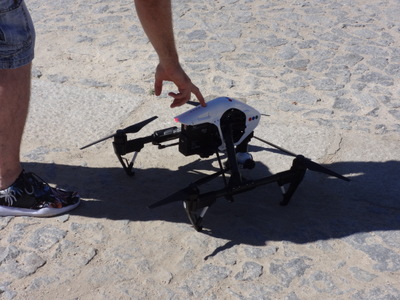
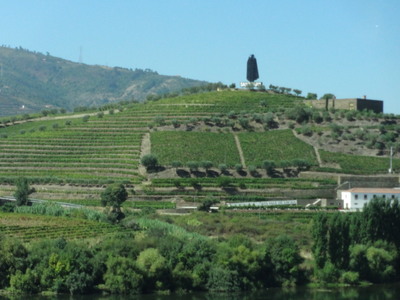 Finally, it came in for a landing on the stones practically at our feet. Here's a shot of the owner touching it to provide scale. He changed the film, or maybe the battery, and sent it off again.
Finally, it came in for a landing on the stones practically at our feet. Here's a shot of the owner touching it to provide scale. He changed the film, or maybe the battery, and sent it off again.
Alas, at this point, we had to reboard the buses and head back to meat the ship. Once again, we passed this giant Sandeman figure on its hilltop above the river.
Back in Régua, we found the quay extremely busy! The Viking Torgil was there, on its way upriver, and things were so crowded that the Hemming had had to moor alongside the CroisiEurope Vasco da Gama; we had to board the Vasco and cross it amidships to get to our own ship.
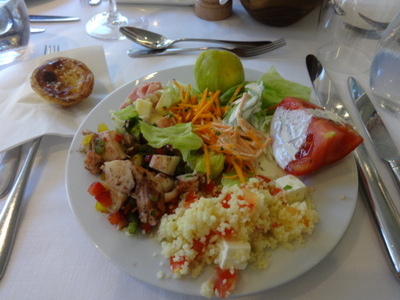
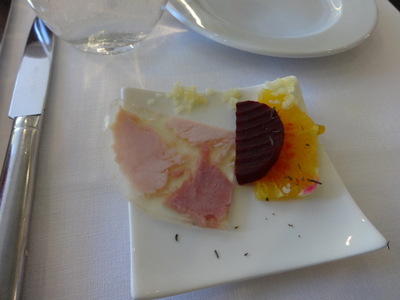 Once aboard, though, we found lunch ready and waiting for us. At the left here is my main plate of hors d'oeuvres from the buffet. Clockwise from the top, a green fig above some tossed salad; a tomato wedge; a sort of tabouleh of couscous, tomatoes, and feta cubes; and a sort of antipasto salad with some chicken in it. At the top left, a miniature pastel de nata that I snagged off the coffee station as we went by.
Once aboard, though, we found lunch ready and waiting for us. At the left here is my main plate of hors d'oeuvres from the buffet. Clockwise from the top, a green fig above some tossed salad; a tomato wedge; a sort of tabouleh of couscous, tomatoes, and feta cubes; and a sort of antipasto salad with some chicken in it. At the top left, a miniature pastel de nata that I snagged off the coffee station as we went by.
At the right are the two starters actually listed on the menu: a salad of beets and oranges and a "turkey terrine" (chunks of moist cooked turkey embedded in a stiff turkey aspic and sliced). The Portuguese word for turkey is péru—its all in where the bird was most recently imported from when it was named.
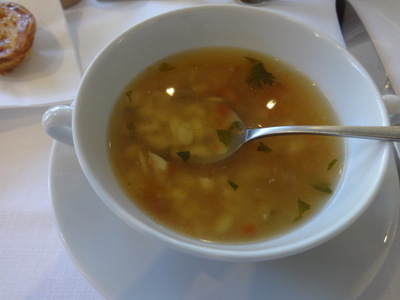
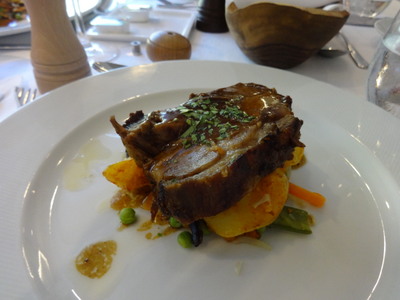 Next came something described simply as "fish soup," but as you can see it also included beans and little bits of carrots, herbs, and whatnot.
Next came something described simply as "fish soup," but as you can see it also included beans and little bits of carrots, herbs, and whatnot.
The main-course choices were roast wild pork with roasted potatoes and vegetables, four-cheese farfalle pasta, and a BLT wrap. Needless to say, we all went for the pork, which was dark, tender, and succulent—superb.
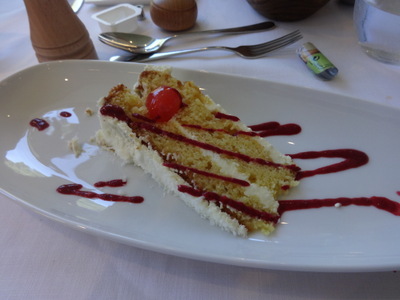
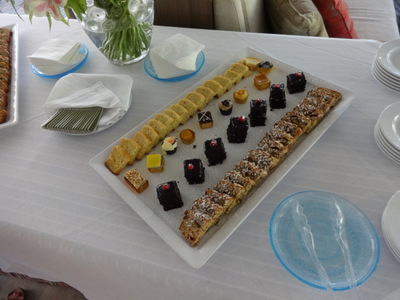 Dessert was either coconut cake or chocolate gelato. Again, for me, that's not even a choice; I love coconut cake. I doubt the coconuts were grown in Portugal, but they probably came from a former colony.
Dessert was either coconut cake or chocolate gelato. Again, for me, that's not even a choice; I love coconut cake. I doubt the coconuts were grown in Portugal, but they probably came from a former colony.
While we ate, the ship cast off to head downstream back to Porto.
At 2:30 p.m., cruise director Alexandra gave a presentation on other Viking cruises, in case we wanted to sign up for any on the spot. Rather than trying to do the whole range in a short time, she concentrated on three European itineraries. The German one seemed great, but it had only two discount departure dates, both of which would conflict with our annual holiday travel. The French trip down the Rhône sounded wonderful, too, but we've already spent three days to a week in each place where that cruise spends a day, so it didn't seem cost effective. David also pointed out how frustrating it would be to sit in a Viking dining room, eating a perfectly lovely dinner, within actual sight of a restaurant on shore that we knew from personal experience could do way better.
Our tiles—the ones we made during our tour of the tile museum in Lisbon—showed up, all glazed and shiny, at which point we paid for that tour and collected our tiles to take home.
The wheelhouse tour was at 3:45 p.m., but I chose to transcribe my notes instead. Then it was time for tea. At the right above is one of the trays of little goodies they layed out while servers came around taking tea, coffee, and drink orders. Tea led right into the cocktail hour, while the shipboard musician played.
At 6:45, we had the usual predinner briefing, reminding us of the schedule for the following morning. We had to be out of our staterooms by 9 a.m., so that the maids could start cleaning in time to have them ready for the arrival of the next boatload of passengers, who would be arriving from Lisbon that evening. But those who, like us, didn't need to be off at the crack of dawn to catch early flights were welcome to leave our luggage outside our doors and repair to the lounge to wait for our transport. All the taxis were booked, she assured us, and we would be called in turn when ours arrived.
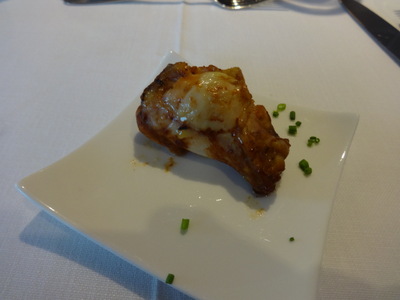
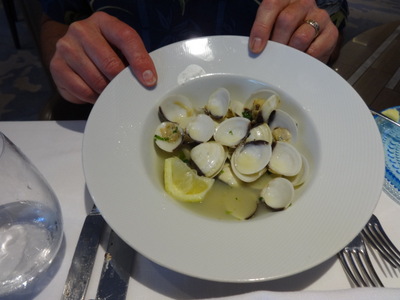 Then, just as we docked in Porto, dinner was served. The amuse-bouche was a single barbecued chicken wing.
Then, just as we docked in Porto, dinner was served. The amuse-bouche was a single barbecued chicken wing.
Among us, we chose three of the four first-course options. Buz started, as he does at every opportunity, with clams cooked in garlic broth. He let me taste one—yummy!
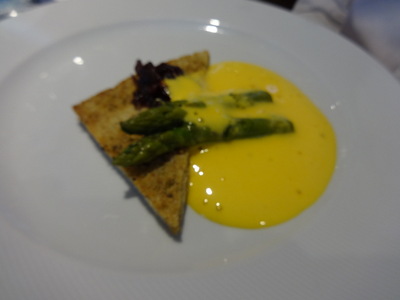
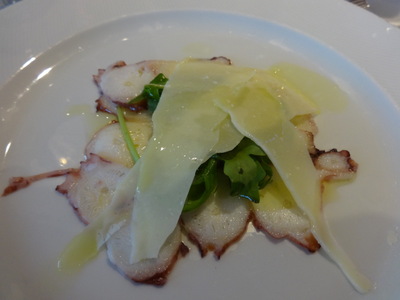 David chose the asparagus on pastry with hollandaise sauce.
David chose the asparagus on pastry with hollandaise sauce.
I too choose clams at almost every opportunity, but I was tempted away from them on this occasion by the chance to have carpaccio of octopus instead. Kathy made the same choice. It was cold, dressed wtih a light vinaigrette, and topped with arugula and thin slices of Parmesan. I suspect that, if I had asked, they would cheerfully have served me both the clams and the octopus, but that seemed a little over the top, considering how much I'd been eating as it was.
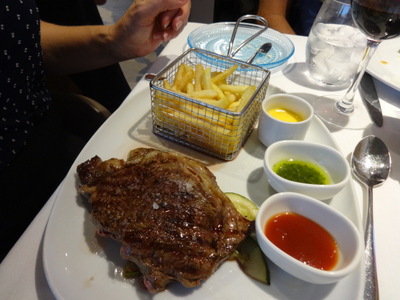
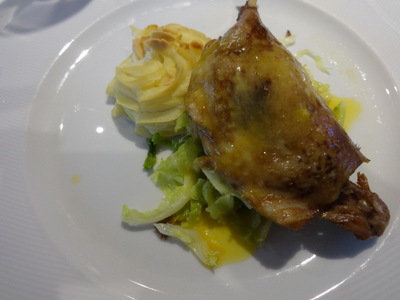 The main course choices were grilled tuna steak with sweet potato and broccoli; confit leg of duck with duchesse potatoes, vegetables, and orange sauce; and buckwheat crepe stuffed with vegetables, topped with cheese sauce, and grilled.
The main course choices were grilled tuna steak with sweet potato and broccoli; confit leg of duck with duchesse potatoes, vegetables, and orange sauce; and buckwheat crepe stuffed with vegetables, topped with cheese sauce, and grilled.
Predictably, David, Buz, and I chose the duck, but Kathy decided to try one of the "always on the menu" items, the gorgeous New York steak in the left-hand photo, which came with its own little fryer basket of fries, pickles, and various sauces.
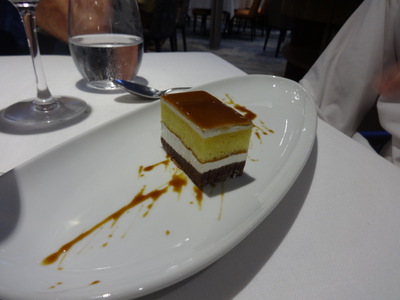
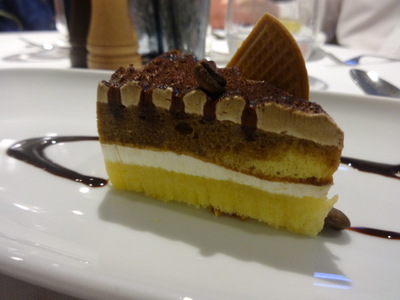 Dessert choices were caramel cake (left), tiramisu cake (right), tangerine sorbet, and sliced pineapple.
Dessert choices were caramel cake (left), tiramisu cake (right), tangerine sorbet, and sliced pineapple.
Somebody ordered the sorbet, but I ordered the tiramisu cake and David had the caramel cake.
After dinner, we had the choice of going ashore to explore the festive Porto waterfront, staying aboard for music and dancing in the lounge, or, as David and I did, going up to the observation deck and watching the waterfront. It was busy with people strolling, fishing in the river, dining indoors or al fresco, and generally enjoying themselves.
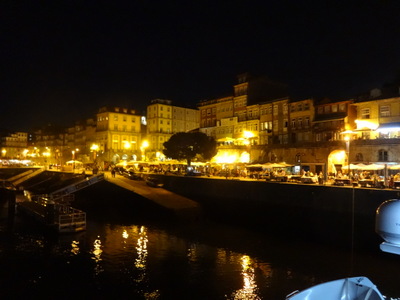
 Here's a farewell view of the warmly illuminated waterfront and, at the right, our final artistically folded bedlinens. I'm not sure what it is—a snake? a bird? a seal?—but it's charming.
Here's a farewell view of the warmly illuminated waterfront and, at the right, our final artistically folded bedlinens. I'm not sure what it is—a snake? a bird? a seal?—but it's charming.
Previous entry
List of Entries
Next entry

 In keeping with the traditions of the time, the chapel had to be really high up and really difficult to walk to. The left-hand photo is a view from the square in front of the town's museum up the long sloping avenue leading toward the hill, and then up the monumental stairway that zigzags up a dozen terraces to the chapel at the top (686 steps). The day we were there was the first day of the chapel's annual festival, so the view was heavily festooned with strings of colored lights. Presumably in normal times it doesn't look quite so much like it's been taken over by the utility companies.
In keeping with the traditions of the time, the chapel had to be really high up and really difficult to walk to. The left-hand photo is a view from the square in front of the town's museum up the long sloping avenue leading toward the hill, and then up the monumental stairway that zigzags up a dozen terraces to the chapel at the top (686 steps). The day we were there was the first day of the chapel's annual festival, so the view was heavily festooned with strings of colored lights. Presumably in normal times it doesn't look quite so much like it's been taken over by the utility companies.
 Here we are (David, Buz, Kathy, and me) under one of the chestnut trees.
Here we are (David, Buz, Kathy, and me) under one of the chestnut trees. 
 After our tour of the chapel and time spent admiring the views in all directions and the lovely and ancient plantings, we caught the Viking bus back down to the square.
After our tour of the chapel and time spent admiring the views in all directions and the lovely and ancient plantings, we caught the Viking bus back down to the square.

 Here are several varieties of potatoes, squashes/gourds, and tomatoes. We also saw other colors of potatoes, onions, red and green bell peppers, and fresh greens.
Here are several varieties of potatoes, squashes/gourds, and tomatoes. We also saw other colors of potatoes, onions, red and green bell peppers, and fresh greens.

 The fish were mostly offered whole, although some of the larger ones, like salmon, could be bought in chunks or slices. I could identify hake, bar (sea bass), something that looked like pale snappers, salmon, a gadid or some sort, sardines, mackerel-like things, and a couple of others about which I have no clue (like the three redish buys in the right-hand photo and the ones in the bin to their right, which might be scombrids, I guess; can anybody give me a hint?).
The fish were mostly offered whole, although some of the larger ones, like salmon, could be bought in chunks or slices. I could identify hake, bar (sea bass), something that looked like pale snappers, salmon, a gadid or some sort, sardines, mackerel-like things, and a couple of others about which I have no clue (like the three redish buys in the right-hand photo and the ones in the bin to their right, which might be scombrids, I guess; can anybody give me a hint?).
 The market was great, but the real highlight was the theme of this year's festival—antique fire engines! Dozens had been gathered from all over the region and lined up along the broad central avenue. Some were roped off, but many were available for touching, close inspection, and even climbing aboard!
The market was great, but the real highlight was the theme of this year's festival—antique fire engines! Dozens had been gathered from all over the region and lined up along the broad central avenue. Some were roped off, but many were available for touching, close inspection, and even climbing aboard!
 No clinging to the running boards for these firemen; the engine had seats like a bus, to make sure everyone got there.
No clinging to the running boards for these firemen; the engine had seats like a bus, to make sure everyone got there.
 The Viking bus drivers were delighted with the fire engines, examining them minutely and even peering under the hoods. Here's our driver posing with a fire-chief's jeep while a colleague from a different bus takes his photo. We had communicated with him all with by gesture and occasional help from Kathy, who speaks some Portuguese. Only on this occasion did it happen to come out that he had lived and worked in France and spoke perfectly good French! Too bad it took us so long to find out, as we would have very much liked to talk more with him in the course of the cruise.
The Viking bus drivers were delighted with the fire engines, examining them minutely and even peering under the hoods. Here's our driver posing with a fire-chief's jeep while a colleague from a different bus takes his photo. We had communicated with him all with by gesture and occasional help from Kathy, who speaks some Portuguese. Only on this occasion did it happen to come out that he had lived and worked in France and spoke perfectly good French! Too bad it took us so long to find out, as we would have very much liked to talk more with him in the course of the cruise.

 Finally, it came in for a landing on the stones practically at our feet. Here's a shot of the owner touching it to provide scale. He changed the film, or maybe the battery, and sent it off again.
Finally, it came in for a landing on the stones practically at our feet. Here's a shot of the owner touching it to provide scale. He changed the film, or maybe the battery, and sent it off again.
 Once aboard, though, we found lunch ready and waiting for us. At the left here is my main plate of hors d'oeuvres from the buffet. Clockwise from the top, a green fig above some tossed salad; a tomato wedge; a sort of tabouleh of couscous, tomatoes, and feta cubes; and a sort of antipasto salad with some chicken in it. At the top left, a miniature pastel de nata that I snagged off the coffee station as we went by.
Once aboard, though, we found lunch ready and waiting for us. At the left here is my main plate of hors d'oeuvres from the buffet. Clockwise from the top, a green fig above some tossed salad; a tomato wedge; a sort of tabouleh of couscous, tomatoes, and feta cubes; and a sort of antipasto salad with some chicken in it. At the top left, a miniature pastel de nata that I snagged off the coffee station as we went by.
 Next came something described simply as "fish soup," but as you can see it also included beans and little bits of carrots, herbs, and whatnot.
Next came something described simply as "fish soup," but as you can see it also included beans and little bits of carrots, herbs, and whatnot.
 Dessert was either coconut cake or chocolate gelato. Again, for me, that's not even a choice; I love coconut cake. I doubt the coconuts were grown in Portugal, but they probably came from a former colony.
Dessert was either coconut cake or chocolate gelato. Again, for me, that's not even a choice; I love coconut cake. I doubt the coconuts were grown in Portugal, but they probably came from a former colony.
 Then, just as we docked in Porto, dinner was served. The amuse-bouche was a single barbecued chicken wing.
Then, just as we docked in Porto, dinner was served. The amuse-bouche was a single barbecued chicken wing.
 David chose the asparagus on pastry with hollandaise sauce.
David chose the asparagus on pastry with hollandaise sauce.
 The main course choices were grilled tuna steak with sweet potato and broccoli; confit leg of duck with duchesse potatoes, vegetables, and orange sauce; and buckwheat crepe stuffed with vegetables, topped with cheese sauce, and grilled.
The main course choices were grilled tuna steak with sweet potato and broccoli; confit leg of duck with duchesse potatoes, vegetables, and orange sauce; and buckwheat crepe stuffed with vegetables, topped with cheese sauce, and grilled.
 Dessert choices were caramel cake (left), tiramisu cake (right), tangerine sorbet, and sliced pineapple.
Dessert choices were caramel cake (left), tiramisu cake (right), tangerine sorbet, and sliced pineapple.
 Here's a farewell view of the warmly illuminated waterfront and, at the right, our final artistically folded bedlinens. I'm not sure what it is—a snake? a bird? a seal?—but it's charming.
Here's a farewell view of the warmly illuminated waterfront and, at the right, our final artistically folded bedlinens. I'm not sure what it is—a snake? a bird? a seal?—but it's charming.